Dinner ready in 20 minutes with this quick bucatini pomodoro - Learn all the tips to make the authentic Italian pasta al pomodoro recipe!
This bucatini pomodoro is basically Italy on a plate!
Perfect for entertaining or for a quick weeknight dinner, it's ready in just 20 minutes and sure to please both kids and grown-ups.
In Italy, pasta al pomodoro is surely the most loved pasta - we have it every week and never get tired of it!
But what is actually pasta pomodoro?
Pomodoro is the Italian word for tomato, so it's simply pasta with tomato sauce.
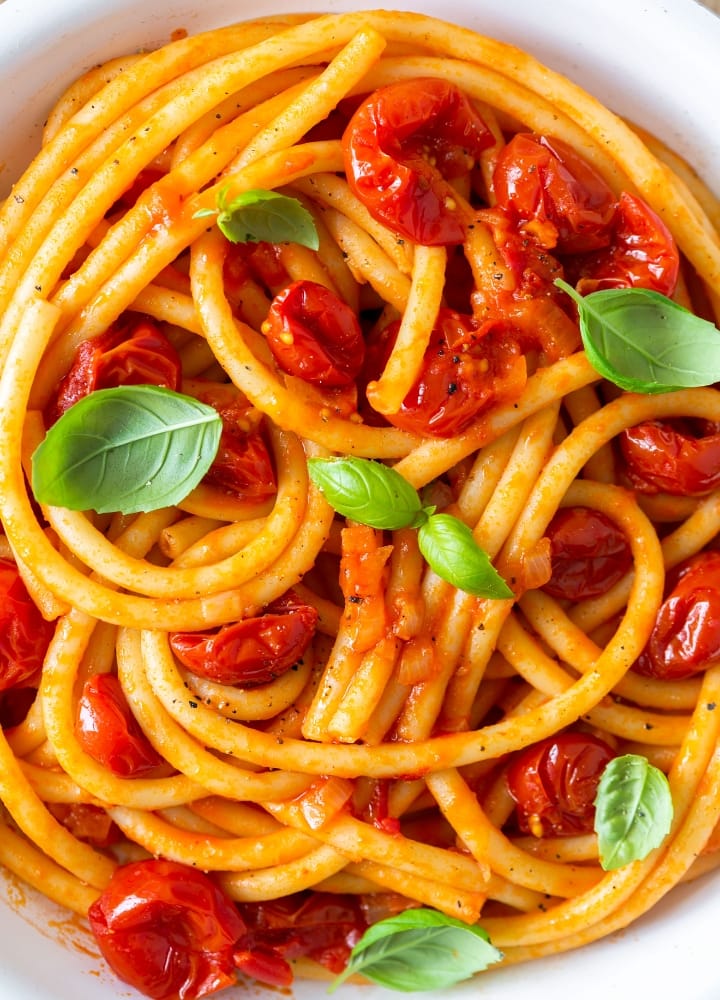
Whilst many like to use spaghetti, I think bucatini is actually one step ahead because it holds the sauce better, making it an even tastier dish.
So if you're looking for a classic quick pasta sauce look no further than this authentic bucatini al pomodoro!
It takes just 20 minutes to make, and it calls for the most simple ingredients such as tomatoes, onion, pasta, extra-virgin olive oil, and fresh basil.
Jump to:
Pomodoro Sauce Vs Marinara Sauce
The main difference between marinara sauce and pomodoro sauce is that the marinara sauce is not cooked, pomodoro sauce on the other end is cooked through.
Another key difference is that marinara sauce features dried oregano, whilst pomodoro sauce calls for fresh basil leaves.
What is Bucatini Pasta?
Bucatini is a pasta shape similar to spaghetti, with a hole running through the center.
It's a traditional pasta shape from the Lazio region. It is commonly used in Italian cuisine, particularly in the regions of Lazio and Campania.
Bucatini is particularly well-suited for hearty sauces, such as amatriciana or carbonara, or a simple tomato sauce.
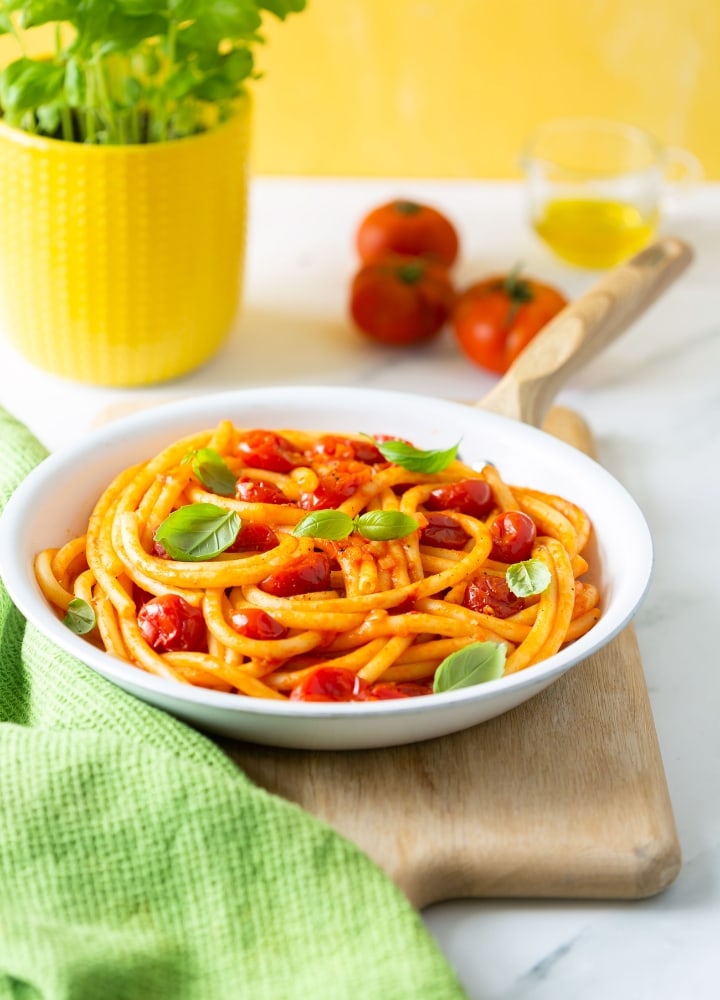
Bucatini Al Pomodoro Ingredients
This bucatini pomodoro recipe is incredibly simple and calls for super basic ingredients.
To make the most of it, pick the best-quality ingredients you can!
Here's what you need to make this simple pasta al pomodoro:
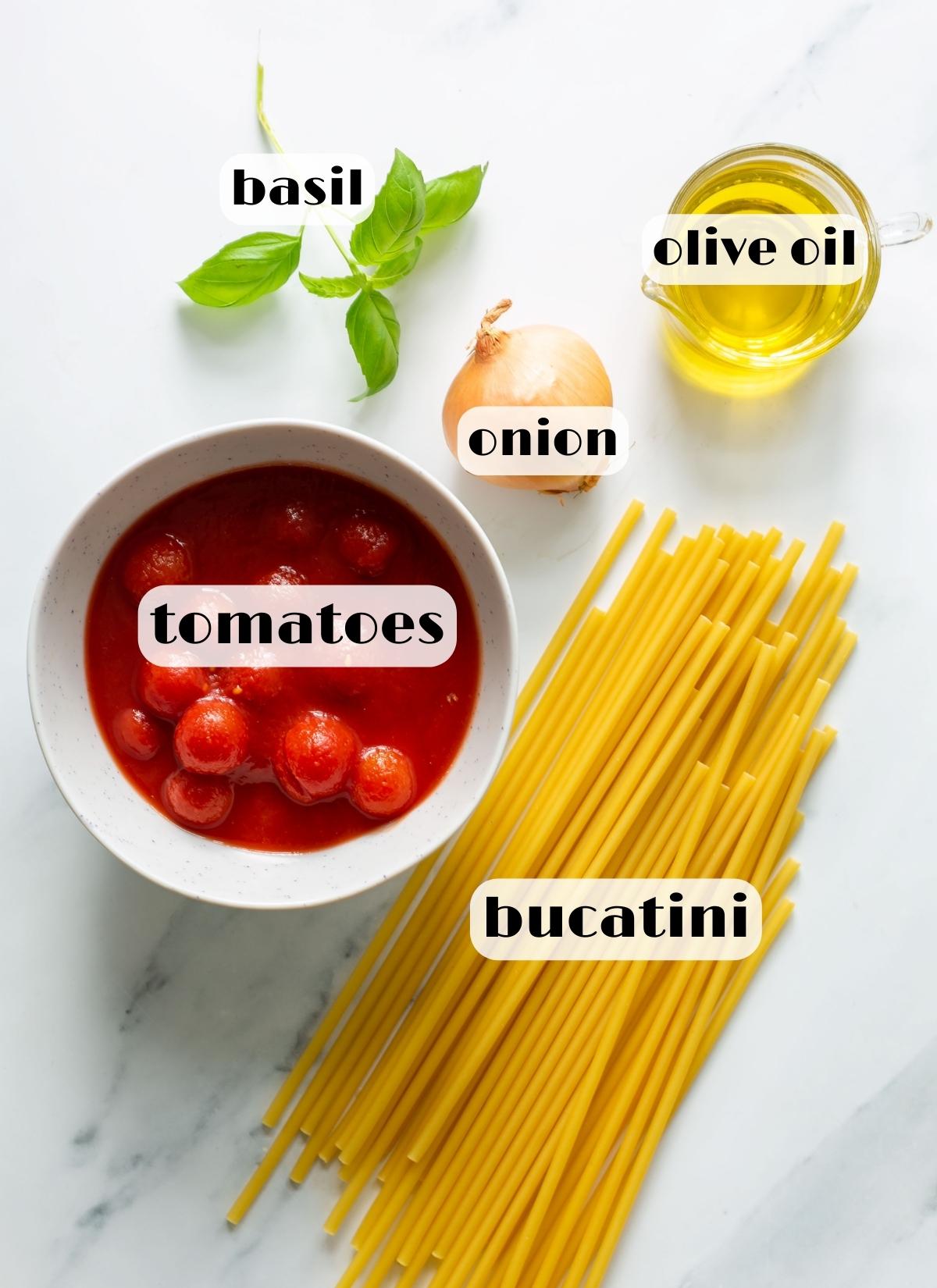
- Pasta: I use bucatini pasta, but spaghetti, penne, rigatoni and fusilli all work well too.
- Tomatoes: I used Italian canned cherry tomatoes, San Marzano tomatoes or datterini tomatoes are also perfect options. When they're in season, you can use fresh tomatoes too, here's how to make tomato sauce with fresh tomatoes.
- Onion: Adds sweetness to the sauce, you can replace it with garlic or use both.
- Extra-virgin olive oil: Always use high-quality olive oil, which adds an amazing flavor to the sauce.
- Basil: Fresh basil leaves are one of the key ingredients, don't replace them with dried basil.
Additional ingredients:
This simple recipe is incredibly tasty and flavorful as it is, but if you like, you can add some extra ingredients:
- Black or green olives: pitted olives add a nice layer of flavor.
- Red pepper flakes: add a spicy kick to your pomodoro sauce with a pinch of red pepper flakes.
- Mozzarella: pasta with tomato sauce and mozzarella is a family favorite! Just add cubed mozzarella cheese to the tomato sauce, add the pasta, mix and serve.
How To Make Bucatini Pomodoro
The beauty of this simple and quick pasta al pomodoro is that it's ready in just 20 minutes, and it's super easy to make.
Here below is the step-by-step recipe with pictures.
Scroll down until the end of the post for the full printable recipe.
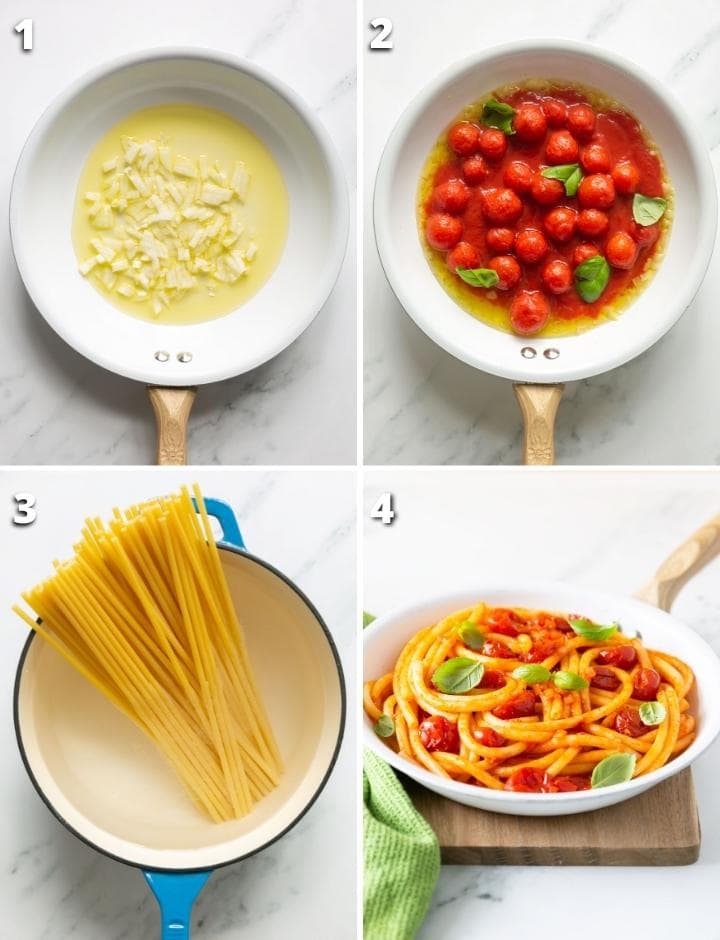
STEP 1. Heat the olive oil and onion in a skillet over medium-low heat.
STEP 2. Add the tomatoes and crush them gently with a wooden spoon. Season with a few basil leaves, cover with a lid, and cook on low heat for 15 minutes, stirring every now and then.
STEP 3. In a large pot of lightly salted boiling water add the pasta and cook according to the package directions. For al dente pasta, drain it 2-3 minutes before the suggested cooking time.
STEP 4. Add the pasta into the skillet with the pomodoro sauce, mix everything together, drizzle with more olive oil, and serve.
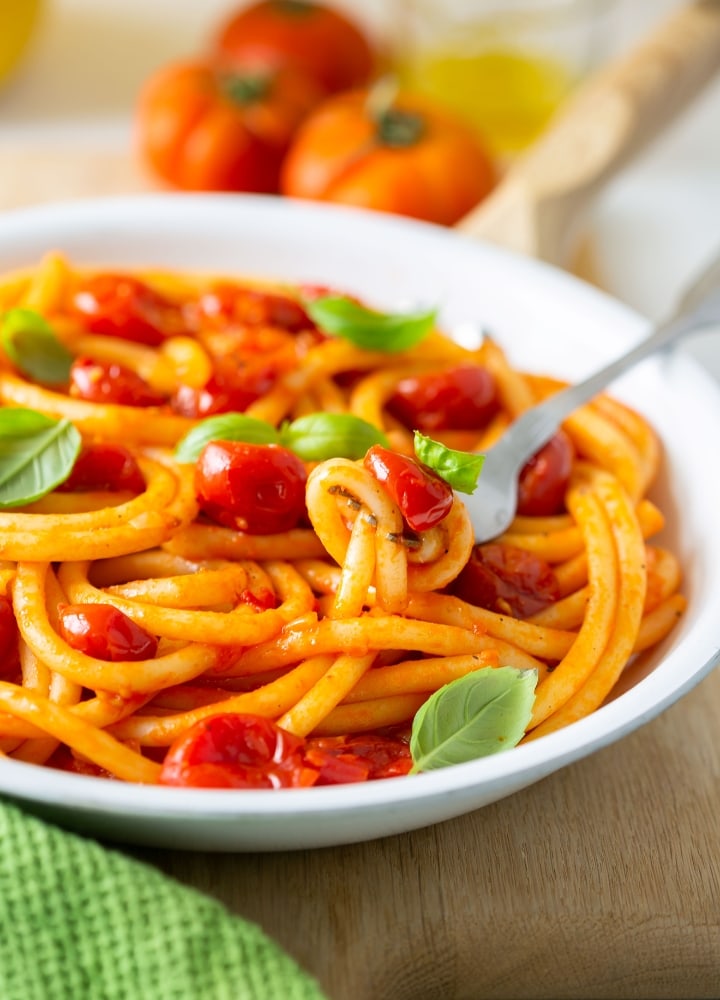
Storage Tips
Store leftover pomodoro pasta sauce in an airtight container and refrigerate for up to 3 days.
Recipe FAQs
If you find the sauce is a bit acidic, simply add a bay leaf whilst it cooks, or a pinch of sugar.
Tomato seeds add bitterness to the sauce, so although it's optional, you can cut each whole canned tomato in half, remove the seeds then proceed with making the sauce.
More Italian Dinner Recipes To Try
- Traditional Italian Pasta e Fagioli
- Pollo alla Cacciatora (Chicken Cacciatore)
- Ricotta Meatballs - Italian Recipe
- Pumpkin Risotto
- Traditional Bolognese Sauce- Beef Ragu'
- Polpette - Italian Meatballs
- Chicken Pizzaiola
- Steak Pizzaiola - Carne alla Pizzaiola
- Authentic Italian Potato Frittata
- Ossobuco alla Milanese
Did You Try This Recipe?
Please let me know how you liked it! Leave a comment below and share a picture on Instagram with the hashtag #thepetitecook!
Don't forget to subscribe to my newsletter and follow along on Facebook, Pinterest and Instagram for all of the latest updates.
Recipe
Bucatini Pomodoro
Ingredients
- 1 medium-large onion, finely minced
- 2 cans organic whole plum tomatoes (15oz/400gr each) , or canned cherry tomatoes
- 2 tablespoon extra-virgin olive oil
- 8 fresh basil leaves
- sea salt and black pepper to taste
- 17.06 oz bucatini pasta
Instructions
- Heat the olive oil in a skillet over medium-low heat, add the chopped onion and cook until translucent, about 4-5 minutes.
- Add the tomatoes and their juice and crush them gently with a wooden spoon. Season with 6 basil leaves, cover with a lid, and cook on low heat for 15 minutes, stirring every now and then. The sauce is ready when it reaches a nice creamy but still chunky texture, and has just the right balance of sweetness and savory when you taste it.
- Meanwhile, in a large pot of lightly salted boiling water add the bucatini pasta and cook according to the package directions. For al dente pasta, drain it 2-3 minutes before the suggested cooking time.
- Remove the pomodoro sauce from the heat, add in the remaining fresh basil leaves, and season with salt and pepper to taste. Fold in the pasta, mix all the ingredients, drizzle with extra-virgin olive oil, and serve.
Notes
Nutrition
The information shown is an estimate provided by an online nutrition calculator. It should not be considered a substitute for a professional nutritionist’s advice.




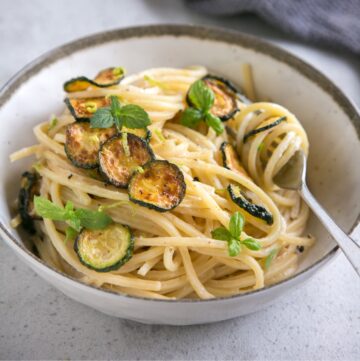
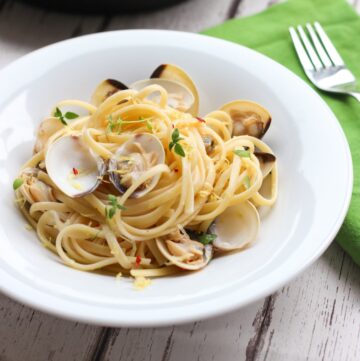
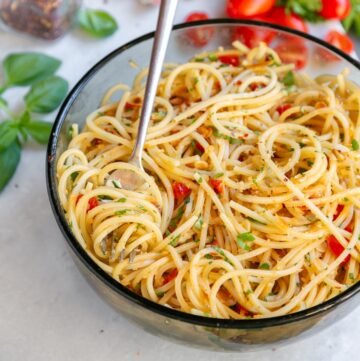
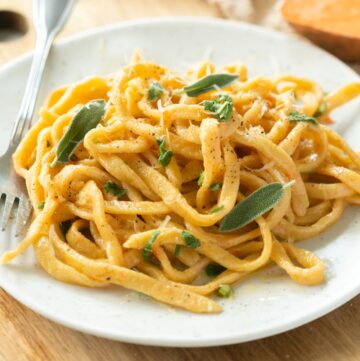
Leave a Reply